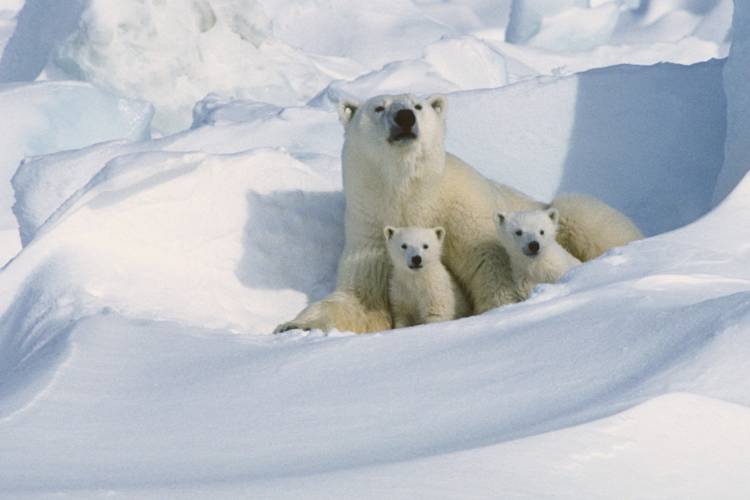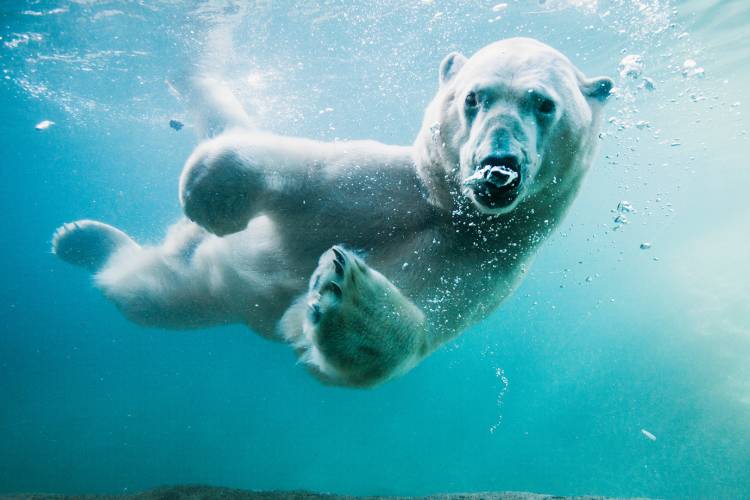It’s summer in the Arctic, and the Hudson Bay polar bears are back on land.
Every year, Polar Bears International works with researchers to track select collared female polar bears from the Western (WH) and Southern (SH) Hudson Bay populations on our Bear Tracker. Following the bears on the sea ice via the Tracker is fascinating, as is watching their return to land during the summer melt period.
A good ice year—so far
This year, Hudson Bay experienced an unusual pattern of sea ice break-up. As part of the Seasonal Sea Ice Ecoregion, Hudson Bay annually freezes each winter and melts each summer. When the ice melts, the region’s polar bears are forced ashore, away from their seal prey. On average the sea ice break-up in Hudson Bay is three to four weeks earlier compared to the 1980s. But each year varies and, this summer, the ice in western Hudson Bay stuck around a bit longer. This translated into a few extra weeks for polar bears to hunt seals and, potentially, to gain many extra pounds. Extra body fat is critically important as these bears now face many months of fasting until the bay refreezes again in November or December.
While on land, away from their seal-hunting grounds, these polar bears must conserve as much body fat as possible. Polar bears have no true hibernation or metabolic changes that allow them to save energy during lean summer months, so they rest—a lot. They will find small amounts of calories when they can (e.g., eggs, berries, carrion), though terrestrial foods offer little energy compared to the bears’ normal blubber-filled diet. In fact, these bears lose up to ~0.9 kilograms per day when on land even while foraging. So, we can only hope that the bears return to land as fat as possible, especially those females who plan to give birth over the winter.
We’ve been following several polar bears who we expect to den and give birth over the winter. These pregnant bears came onshore in late July/early August and won’t see sea ice again until they leave their dens in March. That’s eight months without eating a decent meal, all while giving birth and nursing! Being obese now could help them make it until March with healthy cubs.
Sea ice minimum and fall freeze-up
As Hudson Bay polar bears find a good place to hunker down, stay safe, and rest through the next few months, we will take a short break on the Bear Tracker and keep our eye on sea ice conditions across the Arctic. The loss of July sea ice over the 44-year-satellite record is 68,500 square kilometers (26,400 square miles; an area larger than West Virginia) per year, or 7.2 percent per decade relative to the 1981 to 2010 average. The upcoming annual Arctic sea ice minimum (the lowest ice coverage of the year) occurs each September. When it is announced, we’ll update you on the amount of sea ice loss this year and what it means for polar bears.
Then, in October we will start following new polar bears on the Tracker as the bears gather along the coast to wait for freeze up and the polar bear migration begins. Polar Bears International will again be in Churchill to live stream and narrate the incredible activity and highlight our love of the bears. In the meantime, please check out ways you can join global efforts to support the species by checking out our new Advocacy Toolkit. See you this fall!
Sponsored Bear Updates
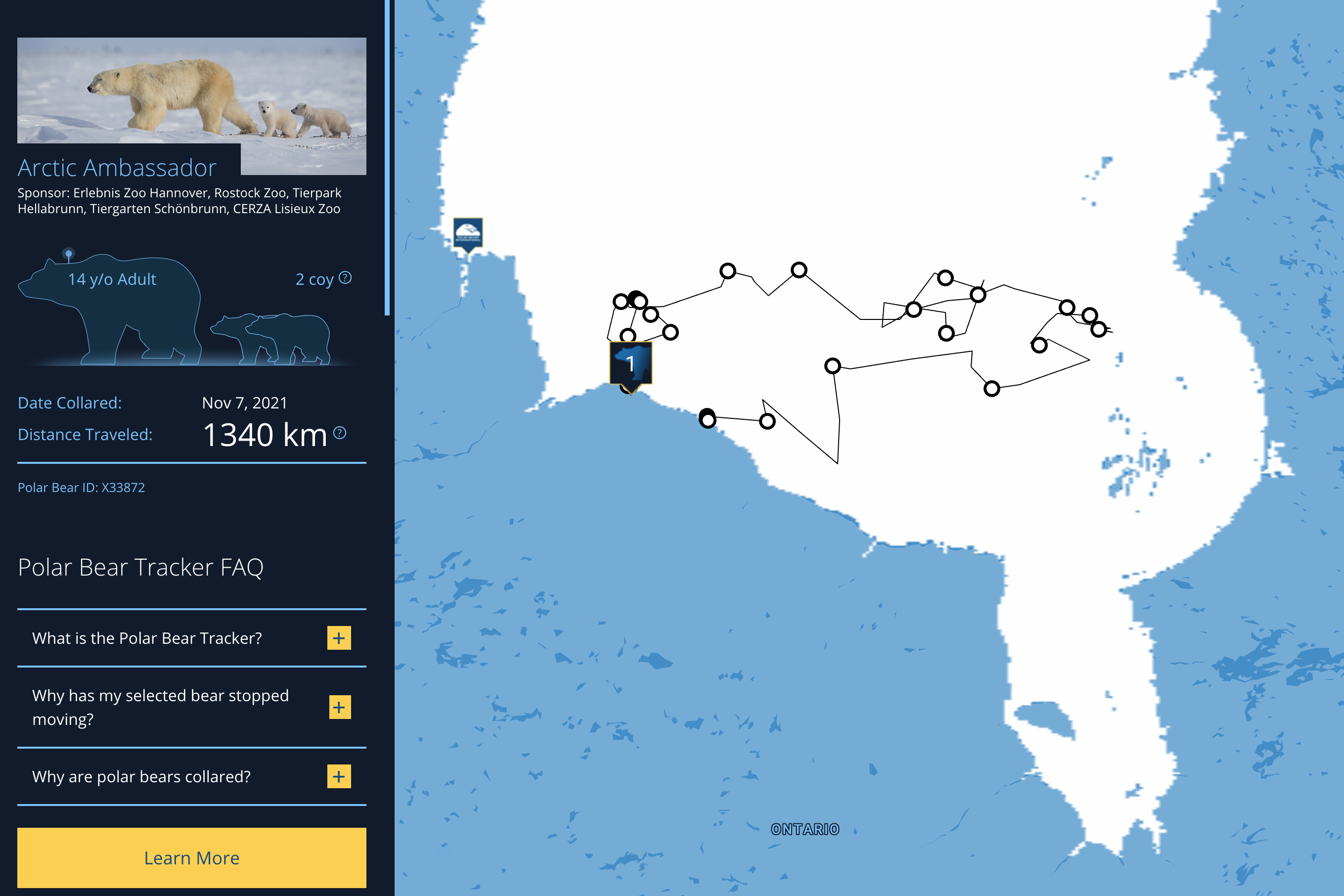
1. Tiergarten Schönbrunn, Erlebnis Zoo Hannover, Rostock Zoo, Tierpark Hellabrunn, CERZA Parc Zoologique Lisieux: X33872, Arctic Ambassador
Arctic Ambassador Bear has just returned to shore! This 15-year-old bear is south of Wapusk National Park with her yearlings after walking a total of 1327 kilometers across the sea ice this winter. During her whole journey she never moved very far north into the bay, mostly heading lateral to the eastern part of the bay and then back again. Getting onto land about August 1st means this family had a few extra weeks to hunt compared to usual, which hopefully translated into more kilograms of body fat. We expect to see them walk to an area and mostly settle down for the summer, during which time they’ll be largely fasting. The cubs are still nursing (but not a lot) and should be a good help to mom with seal hunts when the ice returns in November or December. Until then, good luck to our Arctic Ambassador bear and her cubs, helping us spread polar bear conservation awareness around the world!
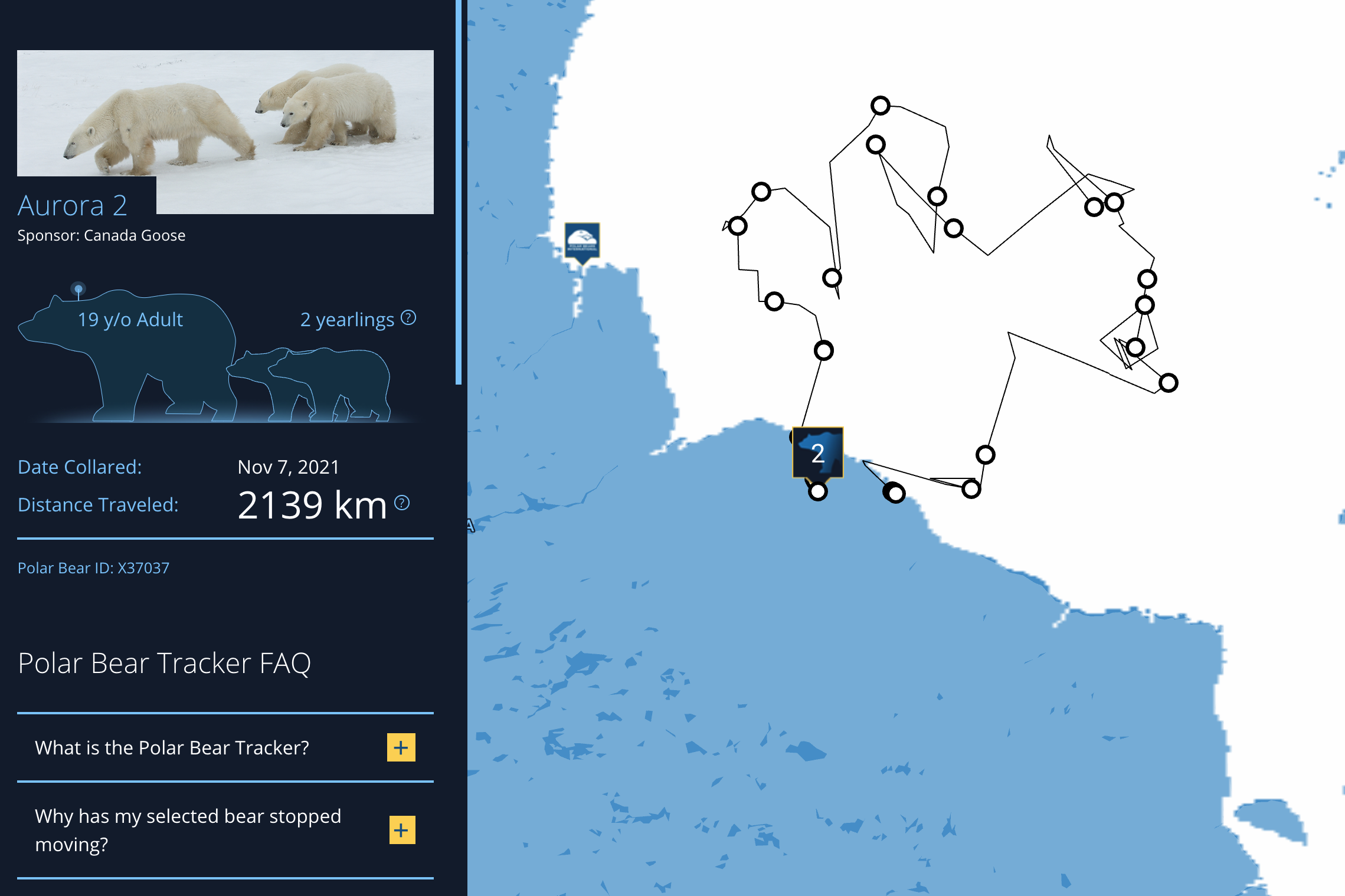
2. Canada Goose: X37037, Aurora 2
Twenty-year-old Aurora 2 returned to the Manitoba shore on her own about July 24th, south of Wapusk National Park. She traveled over 2112 kilometers this past winter, a distance she mostly covered in the west central area of Hudson Bay. The couple extra weeks of hunting seals on sea ice hopefully helped her pack on the pounds since she is likely hoping to sustain a pregnancy over the winter. We think Aurora 2 mated this spring and will now spend a few months finding a good place to den. She’ll enter a den this fall and give birth over the winter, not emerging again until next March. That means, she will go from July to March without a decent meal – eight months! We hope she has enough body fat to sustain herself and any new cub(s); polar bears need to be at least 190 kilograms to successfully produce cubs. Good luck to Aurora 2 and her future cubs!
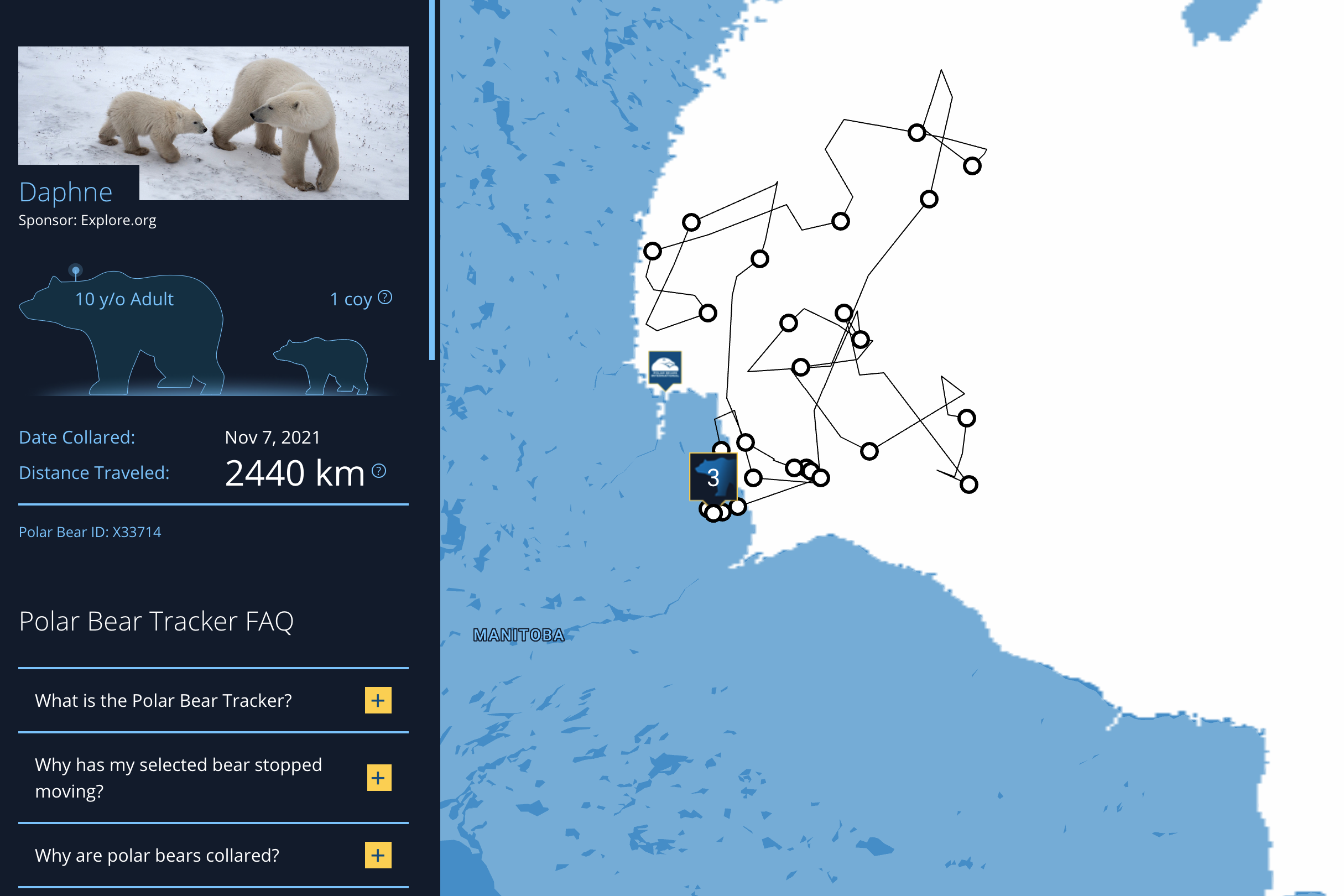
3. Explore.org: X33714, Daphne
Eleven-year-old Daphne returned to land with her yearling around August 1st after traveling over 2438 kilometers around western Hudson Bay during the winter. She returned to land in southern Wapusk National Park, almost exactly where we started tracking her last fall—she knows what she likes! Daphne and cub will now hunker down for the summer, maybe grazing on berries but mostly conserving energy for the lean months on land ahead. Hopefully the couple extra weeks on hunting helped them out as they’ll now wait until the ice returns in November or December before hunting seals again. Her cub will still be nursing (a bit) and is still largely dependent on mom to learn all the lessons needed to be a successful polar bear. We bet Daphne is doing a fabulous job and wish her and cub a restful summer and early freeze-up!

4. Frontiers North Adventures: X33505, Floe
Fifteen-year-old Floe returned to the Manitoba shore around August 2nd, in southern Wapusk National Park. She traveled over 2189 kilometers across Hudson Bay this past winter, staying exclusively in the western half of Hudson Bay but traveling a little farther north than many of the other bears at times. The couple extra weeks of hunting hopefully helped her pack on the pounds since she is likely hoping to sustain a pregnancy over the winter. We think Floe mated this spring and will now spend a few months finding a good place to den. She’ll enter a den this fall and give birth over the winter, not emerging again until next March. That means, she will go from July to March without a decent meal – eight months! We hope she has enough body fat to sustain herself and any new cub(s); polar bears need to be at least 420 lbs to successfully produce cubs. Good luck to Floe and her future cubs!
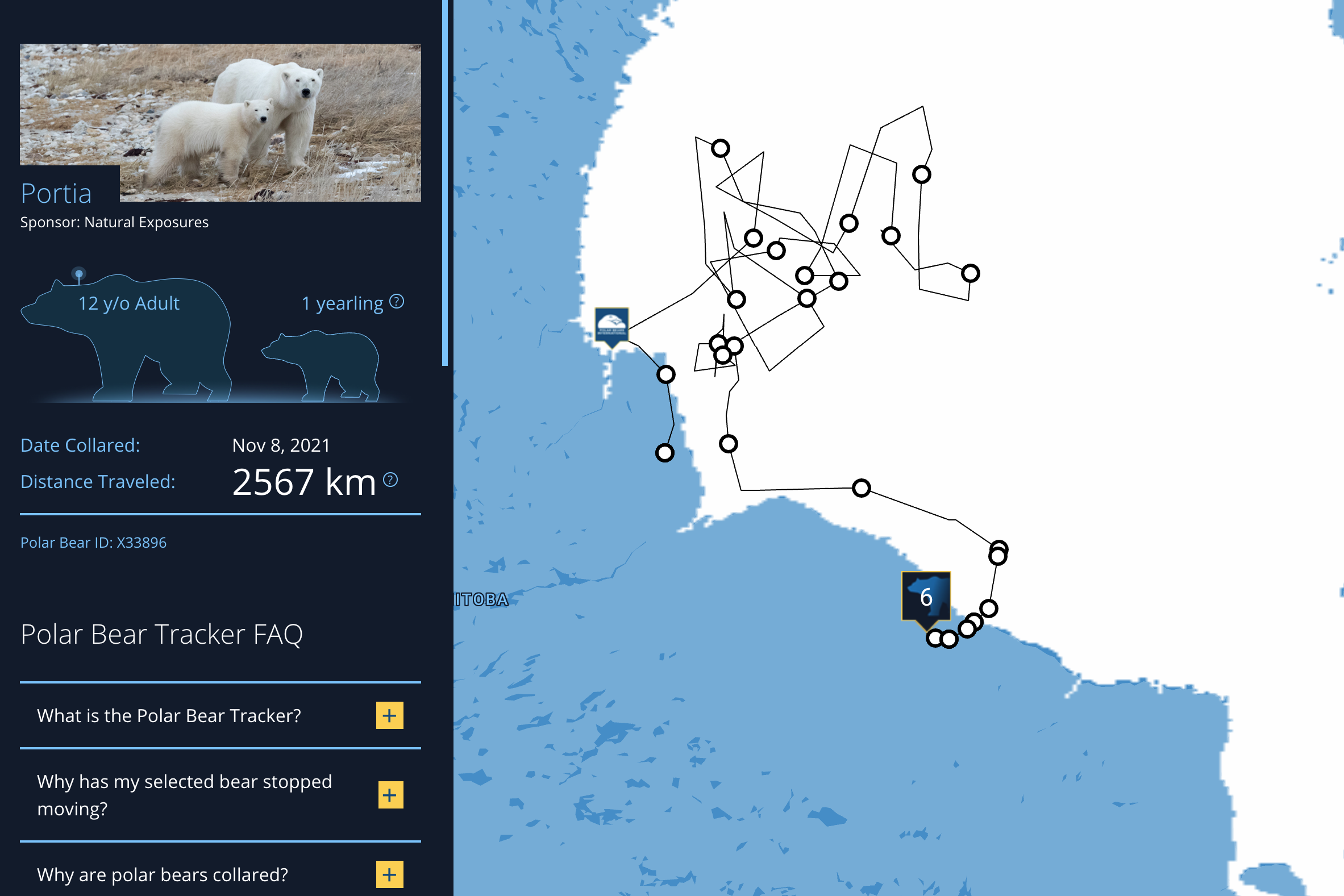
6. Natural Exposures: X33896, Portia
Remaining one of our biggest travelers and covering over 2546 km this past winter, Portia arrived onshore in Ontario around July 27th, single and ready to relax. Portia spent her winter zigzagging in the western half of Hudson Bay, shifting directions whenever needed. The couple extra weeks of hunting hopefully helped her pack on the pounds since she is likely hoping to sustain a pregnancy over the winter. We think Portia mated this spring and will now spend a few months finding a good place to den. She’ll enter a den this fall and give birth over the winter, not emerging again until next March. That means, she will go from July to March without a decent meal – 8 months! We hope she has enough body fat to sustain herself and any new cub(s); polar bears need to be at least 420 lbs to successfully produce cubs. Good luck to Portia and her future cubs!




